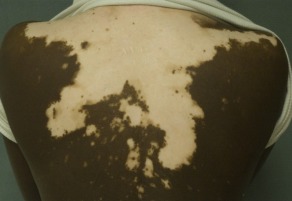Vitiligo: NLRP1
About NLRP1 and Vitiligo

Figure 1: A patient with vitiligo [6]
Vitiligo
Vitiligo is a rare and chronic autoimmune disease in which the body attacks its own melanocytes in the epidermis, causing depigmentation in irregular patches of skin and hair. Vitiligo affects approximately 1 to 2 million Americans[1] and less than one percent of people worldwide.
Vitiligo is believed to be a heritable autoimmune disease, as many patients with the disease can trace a history of the disease within their family. However, sporadic incidences of the disease in which there is no familial history have also been reported. Of those with reported cases of vitiligo, skin color or ethnic origin[1] has not been linked to its incidence.
Recent research[2] conducted on a group of patients with vitiligo has linked the disease with a gene associated with immune system response. The gene, known as NLRP1 (or formerly NALP1), controls part of the immune system that is responsible for reacting to bacterial and viral attack on the body. Researchers have found that if this gene is over-reactive, it will respond to stimuli that should not, under normal gene function, trigger an immune response. Over-reactive NLRP1 has been observed in patients with vitiligo, resulting in the immune system attacking its own melanocytes, causing visible depigmentation in skin and hair.
Vitiligo is a rare and chronic autoimmune disease in which the body attacks its own melanocytes in the epidermis, causing depigmentation in irregular patches of skin and hair. Vitiligo affects approximately 1 to 2 million Americans[1] and less than one percent of people worldwide.
Vitiligo is believed to be a heritable autoimmune disease, as many patients with the disease can trace a history of the disease within their family. However, sporadic incidences of the disease in which there is no familial history have also been reported. Of those with reported cases of vitiligo, skin color or ethnic origin[1] has not been linked to its incidence.
Recent research[2] conducted on a group of patients with vitiligo has linked the disease with a gene associated with immune system response. The gene, known as NLRP1 (or formerly NALP1), controls part of the immune system that is responsible for reacting to bacterial and viral attack on the body. Researchers have found that if this gene is over-reactive, it will respond to stimuli that should not, under normal gene function, trigger an immune response. Over-reactive NLRP1 has been observed in patients with vitiligo, resulting in the immune system attacking its own melanocytes, causing visible depigmentation in skin and hair.
NLRP1
NLRP1 is located on Chromosome 17 within the human genome. This gene encodes a member of the Ced-4 family of apoptosis proteins, proteins responsible for cell death. These Ced-family members, of which NLRP1 is a part, contain a caspase recruitment domain (CARD). NLRP1 is part of a cascade event of these caspases that regulates an immune response [4]. Caspases, or cystein-aspartic proteases, play an important role in apoptosis, necrosis, and inflammation. In cases of vitiligo, mutations in the NLRP1 gene cause overexpression of certain caspases, resulting in activation of the inflammatory cytokine interleukin-1β. High levels of interleukin-1β are found in patients with vitiligo [5].
Currently, there is no cure for vitiligo. Those with the disease often use topical creams and concealers to diminish the appearance of depigmented patches. Those with severe cases have sometimes resorted to skin grafts and phototherapies. However, with the advent of research that seeks to understand the genetic basis of vitiligo and its connection to other autoimmune diseases, major therapeutic advances are being made to combat vitiligo and other autoimmune diseases at their genetic root. The purpose of this project is to provide information that will serve to educate those curious about the genetic basis of this disease.
Below is a video segment from ABC's news program 20/20 chronicling the hardship one man with vitiligo faces in his personal and professional life.
Currently, there is no cure for vitiligo. Those with the disease often use topical creams and concealers to diminish the appearance of depigmented patches. Those with severe cases have sometimes resorted to skin grafts and phototherapies. However, with the advent of research that seeks to understand the genetic basis of vitiligo and its connection to other autoimmune diseases, major therapeutic advances are being made to combat vitiligo and other autoimmune diseases at their genetic root. The purpose of this project is to provide information that will serve to educate those curious about the genetic basis of this disease.
Below is a video segment from ABC's news program 20/20 chronicling the hardship one man with vitiligo faces in his personal and professional life.
References:
[1]National Institute of Arthritis and Musculoskeletal and Skin Diseases: http://www.niams.nih.gov/Health_Info/Vitiligo/vitiligo_ff.asp#c
[2]Medical News Today: http://www.medicalnewstoday.com/articles/65881.php
[3]Gene Cards: http://www.genecards.org/cgi-bin/carddisp.pl?gene=NLRP1
[4]Entrez Gene: http://www.ncbi.nlm.nih.gov/sites/entrez?Db=gene&Cmd=ShowDetailView&TermToSearch=22861
[5]Pedra, J. H., and S. L. Cassell. "Sensing Pathogens and Danger Signals by the Inflammasome."Current Opinion Immunology 21 (2009): 1-2. Web. http://www.ncbi.nlm.nih.gov/pubmed/19223160
[6]American Skin Association: http://www.americanskin.org/resource/vitiligo.php
This Web page was produced as an assignment for Gen677 at UW-Madison Spring 2010.
[1]National Institute of Arthritis and Musculoskeletal and Skin Diseases: http://www.niams.nih.gov/Health_Info/Vitiligo/vitiligo_ff.asp#c
[2]Medical News Today: http://www.medicalnewstoday.com/articles/65881.php
[3]Gene Cards: http://www.genecards.org/cgi-bin/carddisp.pl?gene=NLRP1
[4]Entrez Gene: http://www.ncbi.nlm.nih.gov/sites/entrez?Db=gene&Cmd=ShowDetailView&TermToSearch=22861
[5]
[6]American Skin Association: http://www.americanskin.org/resource/vitiligo.php
This Web page was produced as an assignment for Gen677 at UW-Madison Spring 2010.
Sarah Hamilton, February 21, 2010

